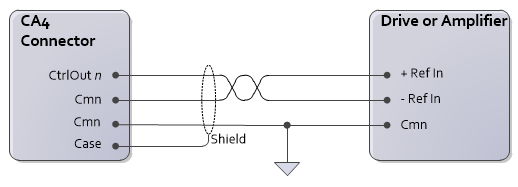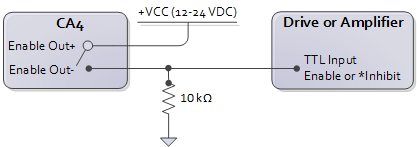
This topic covers the wiring of the RMC200 CA4 Module. The CA4 has 4 analog outputs, individually software selectable as 0-10V, ±10 V, 4-20 mA, or ±20 mA, with unipolar or bipolar operation, or a custom range within the ±10 V or ±20 mA range.
See Wiring Guidelines for general wiring information.
Pin-Out
Terminal Block 1 (top)
|
Description |
|
Pin |
|
Description |
|
|
Voltage or current output 0 |
CtrlOut0 |
1 |
2 |
CtrlOut1 |
Output 1 |
|
Output common |
Cmn |
3 |
4 |
Cmn |
|
|
Output common |
Cmn |
5 |
6 |
Cmn |
|
|
Shield connection |
Case |
7 |
8 |
Case |
|
|
Enable Output 0+ |
EnOut0+ |
9 |
10 |
EnOut1+ |
|
|
Enable Output 0- |
EnOut0- |
11 |
12 |
EnOut1- |
|
|
Fault Input 0+ |
FltIn0+ |
13 |
14 |
FltIn1+ |
|
|
Fault Input 0- |
FltIn0- |
15 |
16 |
FltIn1- |
|
|
Shield connection |
Case |
17 |
18 |
Case |
|
All the Cmn pins in Terminal Blocks 1 and 2 are internally connected.
Terminal Block 2 (bottom)
|
Description |
|
Pin |
|
Description |
|
|
Output 2 |
CtrlOut2 |
1 |
2 |
CtrlOut3 |
Output 3 |
|
Cmn |
3 |
4 |
Cmn |
||
|
Cmn |
5 |
6 |
Cmn |
||
|
Case |
7 |
8 |
Case |
||
|
EnOut2+ |
9 |
10 |
EnOut3+ |
||
|
EnOut2- |
11 |
12 |
EnOut3- |
||
|
FltIn2+ |
13 |
14 |
FltIn3+ |
||
|
FltIn2- |
15 |
16 |
FltIn3- |
||
|
Case |
17 |
18 |
Case |
||
All the Cmn pins in Terminal Blocks 1 and 2 are internally connected.
Wiring to Differential Inputs
The CA4 analog outputs provide ±10 V, 4-20 mA, or ±20 mA.
Wiring the CA4 Analog Output to Differential Inputs
Differential inputs provide the best noise immunity. This is indicated by individual +, -, and cmn inputs on the drive or amplifier. The CA4 provides two Analog Output Common pins per analog output to make analog differential wiring easy.

Wiring to Single-ended Inputs

Fault Input Wiring
The Fault input is compatible with signal levels ranging from 12V to 24V. The Fault Input draws 3mA maximum and turns on at 9V. The Fault input turns on when a current flows. The polarity of the voltage is unimportant. See the Fault Input topic for more details.
|
Generic: |
From Open Collector Output:
|
Enable Output Wiring
The Enable output is a solid state relay (SSR). When it is off, it has high impedance, and when on it has low impedance (12 Ω maximum). Because the Enable output is isolated, the user must power it externally. The maximum current and voltage for the Enable output is 75 mA and 30 V.
The Enable output has a + and - connection. Both lines must be connected for the output to function. Because both sides of the output are provided, the switches may be independently connected in a high side or low side configuration (that is, with the load (input) on the source or sinking side of the output). See the wiring diagrams below.
See the Enable Output topic for more details on the Enable Output.
To active low Enable input:

To TTL input (high = enable):

Using Outputs with Inductive Loads
External fuses should be used to protect the SSRs if there is a possibility of over-current. When switching inductive loads, it is important to place a diode or tranzorb across the load to protect the switch when transitioning from an “ON” to an “OFF” state. Otherwise, the collapsing magnetic field can cause a reverse voltage spike in excess of the 30 V rating of the SSR.
See Also
Copyright © 2025 Delta Computer Systems, Inc. dba Delta Motion